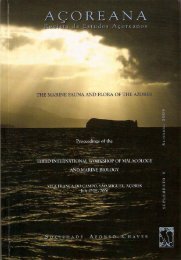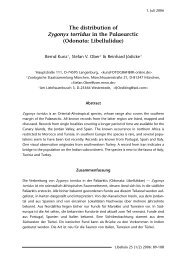On the taxonomy and natural history of Oxypoda brachyptera and O ...
On the taxonomy and natural history of Oxypoda brachyptera and O ...
On the taxonomy and natural history of Oxypoda brachyptera and O ...
You also want an ePaper? Increase the reach of your titles
YUMPU automatically turns print PDFs into web optimized ePapers that Google loves.
Beitr. Ent. 62 (2012) 1<br />
Natural <strong>history</strong>:<br />
Habitat. In nor<strong>the</strong>rn Germany, O. tarda is not particularly rare. The examined material was<br />
found in various unforested, generally in more or less moist habitats on heavier, <strong>of</strong>ten more<br />
or less loamy, or on calcareous soils, particularly in moist meadows, floodplains, arable l<strong>and</strong>,<br />
fallows, <strong>and</strong> in coastal meadows. The species appears to be absent from dry habitats on s<strong>and</strong>y<br />
soils.<br />
According to Lohse (1974), O. tarda occurs in <strong>the</strong> same localities as O. <strong>brachyptera</strong>. However,<br />
<strong>the</strong> present data do not confirm this observation. In <strong>the</strong> vast majority <strong>of</strong> <strong>the</strong> studied sites, only<br />
ei<strong>the</strong>r <strong>of</strong> <strong>the</strong> two species was present. Both species were recorded as syntopic only in a coastal<br />
meadow, in arable l<strong>and</strong>, <strong>and</strong> in a fallow. In most cases <strong>of</strong> syntopic occurrence, at least one <strong>of</strong> <strong>the</strong><br />
two species was represented exclusively by <strong>the</strong> macropterous morph. In localities where ei<strong>the</strong>r <strong>of</strong><br />
<strong>the</strong> two species was very abundant, <strong>the</strong> o<strong>the</strong>r species was always absent (Tab. 2). Thus, regarding<br />
<strong>the</strong>ir respective habitats, O. tarda <strong>and</strong> O. <strong>brachyptera</strong> appear to be clearly segregated.<br />
Phenology:<br />
The epigeic activity period measured with pitfall traps in 1986/1987 lasted from May to <strong>the</strong><br />
first half <strong>of</strong> November. The highest activity was observed from <strong>the</strong> second half <strong>of</strong> May through<br />
June <strong>and</strong> in September (Fig. 28). The sex ratio (males:females) was similar to that <strong>of</strong> O. <strong>brachyptera</strong><br />
(1.27). Mature eggs were found in <strong>the</strong> ovaries <strong>of</strong> dissected females from <strong>the</strong> second half<br />
<strong>of</strong> June through <strong>the</strong> first half <strong>of</strong> August. Teneral adults were observed from <strong>the</strong> second half <strong>of</strong><br />
August through September, with a maximum in <strong>the</strong> second half <strong>of</strong> September. These data suggest<br />
that O. tarda has only one generation per year, that <strong>the</strong> duration <strong>of</strong> pre-imaginal development is<br />
similar to that <strong>of</strong> O. <strong>brachyptera</strong> (1.5-2 months, without diapause), <strong>and</strong> that hibernation occurs<br />
in <strong>the</strong> adult stage.<br />
Fig. 28: Pooled seasonal activity density <strong>of</strong> O. tarda based on pitfall trap studies in Hannover in 1986/1987<br />
(total: 442 specimens). For additional explanations see Fig. 25.<br />
221
















